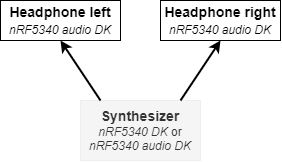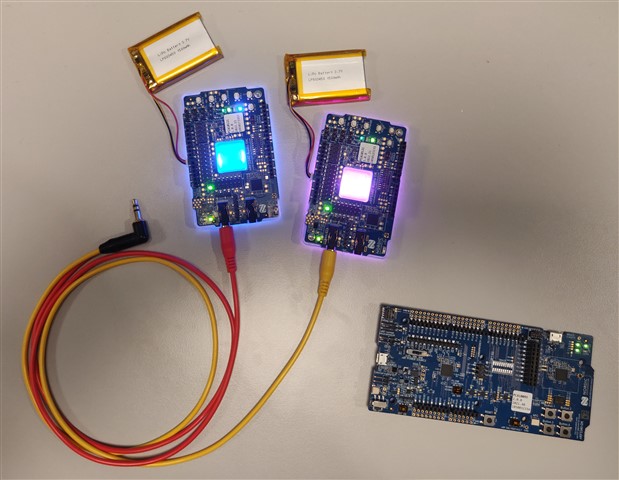I have long been interested in music production and the creation of audio devices lately. Working at Nordic Semiconductor as a student, I learnt about transmitting audio through Bluetooth, which intrigued me. Especially the new and exciting Bluetooth LE Audio, which is supposed to yield better audio quality with less bitrate and less latency. You expect very little latency between your action and the sound response when playing an instrument. I wanted to test if it was possible to utilize the nRF5340 to generate a pleasing sound controlled by a simple keyboard interface and to see if the latency was good enough not to disturb my playing.
The application is assembled as a sound-generating device, the synthesizer, and a receiving headphone. LE Audio allows sending two audio streams corresponding to the left and right parts of the headphone synchronized.

The application is based on the Nordic nrf5340_audio demo application but stripped down and specialized for a synthesizer use case. The main concern of the application is the synthesizer and keyboard input part.
System design

The synthesizer is constructed to be highly modular, making it easy to include or exclude different modules and test with different topologies of audio synthesis. The provided setup demonstrates different aspects of a synthesizer, such as polyphonic oscillators, effects, and audio-synced time dependency.
The synthesizer module receives information on which notes to play and to stop playing from the button module. These notes may be transformed to create a sequencer or in this case, an arpeggiator. The arpeggiator is time-dependent and thus needs a source of time. We must use a source of time synchronized with the sense of time in the processed audio. This is the function of tick_provider, which increments time for each audio block processed. The tick provider sends ticks to subscribing modules. This is the same method MIDI uses to synchronize different audio sources, which makes it possible to implement MIDI synchronization.
For polyphonic synthesis, we need multiple oscillators equal to the number of notes it should be possible to play at once. key_assign keeps track of currently active oscillators and assigns notes to oscillators in a first-inactive (the oscillator which has been inactive for the longest time) manner. If there are no inactive oscillators, it will assign the new note to the first-active (the oscillator which has been active for the longest time) oscillator. The application is, by default, configured to have five oscillators. Even when playing an arpeggiator with more than 5 notes, it is hard to notice the last-inactive note cutting off.
The application is configured to encode mono audio, in audio_process_start. All modules are also constructed as mono. Modifying the application to process stereo audio isn't too hard. The echo effect, for example, may be converted to a stereo ping-pong delay effect. Before the echo effect, split the mono sound into left and right channels. Then input these channels to the echo effect. Make sure to set the pcm_size correctly in sw_codec_encode for stereo encoding.
Signal processing
Audio is processed in blocks of N samples, initiated in audio_process. A timer ensures new blocks are processed in an interval to match audio sample rate. This should probably be directly synced with the Bluetooth connection interval for further development.
Using a bit depth of 16-bit. The DSP is mainly done using integers in a fixed-point format. Thus a type fixed16 is defined with associated manipulations in interger_math. Since the application is specifically targeted towards the nRF5340, the application uses included DSP instructions in the SoC in some cases, abstracted by dsp_instruction.
The block of code below (from oscillator.c) is an example of generating a sinewave with a frequency determined by phase_increment. The upper 8 bits of phase_accumulate, phase_accumulate[24:31], is used to select which stored samples to use, while phase_increment[8:23] is used to determine the interpolation value between these two samples. Then there is an applied magnitude to the signal.
for (uint32_t i = 0; i < block_size; i++) {
/* upper 8 bit as 256-value sample index */
uint32_t wave_index = osc->phase_accumulate >> 24;
/* interpolate between the two samples for better audio quality */
uint32_t interpolate_pos = (osc->phase_accumulate >> 8) & UINT16_MAX;
block[i] = FIXED_INTERPOLATE_AND_SCALE(sinus_samples[wave_index], sinus_samples[wave_index + 1], interpolate_pos, osc->magnitude);
/* increment waveform phase */
osc->phase_accumulate += osc->phase_increment;
}
FIXED_INTERPOLATE_AND_SCALE is provided in integer_math to perform this calculation using DSP instructions on the CPU efficiently.
With the current application configuration, about 80% of the nRF5340 app core is used when all oscillators are active. Around 40% of the app core is used when two headphone devices are connected. A large chunk of this is probably the LC3 encoder.
Latency
The minimum connection interval in Bluetooth Low Energy is 7.5ms. Audio processing is initiated every 7.5ms to match the connection interval. The processing should thus not result in added latency. The new LC3 codec in LE audio, which replaces the SBC codex, is supposed to have much less latency. But this has not been tested in this particular application. The input buttons are configured with a 50ms debounce time. However, this does not contribute to latency. This is because the implementation is such that the button state is assumed to change state whenever a new interrupt is triggered. After the debounce time, this assumption is tested by reading the pin value. This will result in occasional wrong button states but corrected again after the debounce time. This has not resulted in any audible artifacts from tests.
Results
The resulting application has demonstrated a functioning system of transmitting synthesizer audio using BLE LE Audio. For instructions on how to test the application, check out the Github repo. Below is an image of the setup used: 2 nRF5340 Audio DKs as headphones and 1 nRF5340 DK as the synthesizer:

Although no quantitative analysis has been done to determine the total latency, I would say it's not noticeable when playing the keyboard while listening to the resulting sound. The application has demonstrated moderate audio signal processing, which resulted in about 80% CPU usage in the app core of nRF5340. Thus more complex processing, which might be demanded in consumer synthesis devices, may be hard to pull off. That being said, I am sure there are a lot of new and exciting applications enabled by LE Audio on nRF5340.
Programming
For a complete guide, take a look at the project README file. Video below demonstrates programming and testing using 2 nRF5340 Audio DKs:




-
$core_v2_ui.GetResizedImageHtml($comment.User.AvatarUrl, 44, 44, "%{border='0px', alt=$comment.User.DisplayName, ResizeMethod='ZoomAndCrop'}")
$core_v2_ui.UserPresence($comment.User.Id)
$comment.User.DisplayName
-
Cancel
-
Vote Up
$currentVotes.ToString("+0;-0;0")
Vote Down
-
$core_v2_ui.Like($comment.CommentId, $comment.CommentContentTypeId, "%{ Format = $likeFormat, IncludeTip = 'true' }")
-
Sign in to reply
-
More
-
Cancel
Children